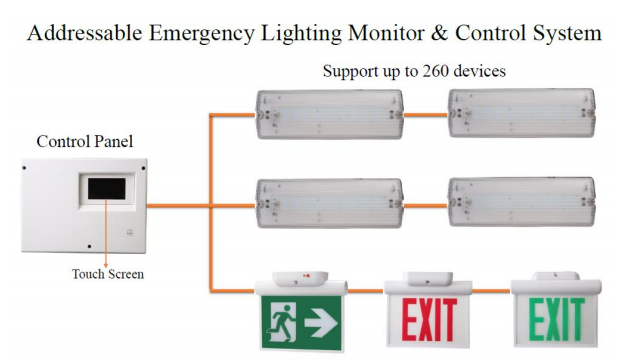
Emergency lighting is an integral part of any building safety system. It provides lighting during power outages or emergencies, ensuring people can safely evacuate the premises and navigate the space. There are several main types of emergency lighting, each with its own unique features, benefits, and applications.
Freestanding light fixtures: Self-contained emergency luminaires are probably the most common type of emergency lighting. These lights are equipped with built-in batteries, allowing them to operate independently in the event of a power outage. Freestanding luminaires are easy to install and maintain, making them a cost-effective option for many buildings. They are available in a variety of designs including exit signs, bulkhead lights and downlights, ensuring there is a suitable choice for every application.
Central battery system: Central battery systems are a centralized method of emergency lighting. In this setup, a single battery backup system powers a network of light fixtures throughout the building. This enables a more coordinated and comprehensive approach to emergency lighting, especially in larger facilities. Centralized battery systems are commonly used in commercial and industrial settings where a high level of reliability and control is required.
Self-check emergency lighting: Self-testing emergency lighting systems are designed to automatically perform periodic diagnostic tests to ensure the fixtures are functioning properly. These systems can detect malfunctions or malfunctions and alert maintenance personnel so that any issues can be resolved promptly. Self-testing emergency lighting reduces the need for manual testing and inspection, making it a convenient and reliable option for many buildings.
Addressable emergency lighting: Addressable emergency lighting systems provide advanced control and monitoring capabilities. Each fixture in the system is assigned a unique address, allowing individual programming and control. This enables precise management of emergency lighting, including the ability to customize light levels, test individual luminaires, and receive detailed status reports. Addressable emergency lighting is often used in complex or high-traffic environments that require a high degree of customization and control.
Maintenance and non-maintenance luminaires: Emergency lighting fixtures can be divided into maintenance and non-maintenance types. Maintained luminaires can operate as regular luminaires under normal conditions and can be manually switched to emergency mode in the event of a power outage. Maintenance-free luminaires, on the other hand, remain off under normal conditions and are only activated in emergencies. The choice of maintenance and non-maintenance fixtures depends on the specific requirements of the building and the preferences of the building owner or operator.
In summary, emergency lighting plays a vital role in ensuring the safety and well-being of building occupants during unforeseen circumstances. By understanding the main types of emergency lighting and their respective benefits, building owners and facility managers can make informed decisions to implement the most appropriate emergency lighting solution for their specific needs. Whether individual luminaires, central battery systems, self-testing systems, addressable systems or maintained/non-maintenance luminaires, there are options to meet the unique requirements of different buildings and their occupants.
Post time: Jan-06-2024









